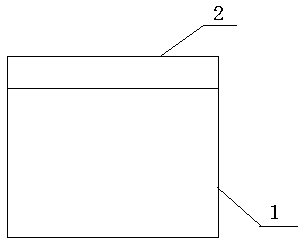Preparation method of near-monocrystalline transparent AlN ceramic composite substrate
A technology of transparent ceramics and ceramic composites, applied in the direction of single crystal growth, single crystal growth, chemical instruments and methods, etc., can solve the problems of disordered crystal orientation, inability to form AlN transparent ceramic structure, poor thermal conductivity of sapphire substrate, etc.
- Summary
- Abstract
- Description
- Claims
- Application Information
AI Technical Summary
Problems solved by technology
Method used
Image
Examples
Embodiment 1
[0028] Embodiment 1, a preparation method of a near-single-crystal double-layer transparent AlN ceramic composite substrate, which includes the following steps, the near-single-crystal double-layer transparent AlN ceramic composite substrate includes a lower near-single-crystal AlN transparent ceramic substrate and an upper layer AlN or GaN quasi-single-crystal layer; the thickness of the near-single-crystal AlN transparent ceramic substrate is 100 microns, the unit cell diameter is 1 micron, does not contain sintering aids, and the c-axis orientation deviation is within 10-20°; the AlN Or the thickness of the GaN quasi-single crystal layer is 5 microns, and the c-axis orientation deviation is within 5°.
[0029] A. The preparation of the near-single-crystal AlN transparent ceramic substrate with the c-axis deviation within 10-20°, which includes the following steps: (1) preparing a powder whose particle size is within 1 micron and the impurity content is less than 0.1%. Pure ...
Embodiment 2
[0033] Embodiment 2, a preparation method of a near-single-crystal double-layer transparent AlN ceramic composite substrate, which includes the following steps, the near-single-crystal double-layer transparent AlN ceramic composite substrate includes a lower near-single-crystal AlN transparent ceramic substrate and an upper layer AlN or GaN quasi-single crystal layer; the thickness of the near-single crystal AlN transparent ceramic substrate is 500 microns, the unit cell diameter is 3 microns, does not contain sintering aids, and the c-axis orientation deviation is within 10-20°; the AlN Or the thickness of the GaN quasi-single crystal layer is 50 microns, and the c-axis orientation deviation is within 5°.
[0034] A. The preparation of the near-single-crystal AlN transparent ceramic substrate with the c-axis deviation within 10-20°, which includes the following steps: (1) preparing a powder whose particle size is within 1 micron and the impurity content is less than 0.1%. Pur...
Embodiment 3
[0038] Embodiment 3, a preparation method of a near-single-crystal double-layer transparent AlN ceramic composite substrate, which includes the following steps, the near-single-crystal double-layer transparent AlN ceramic composite substrate includes a lower near-single-crystal AlN transparent ceramic substrate and an upper layer AlN or GaN quasi-single crystal layer; the thickness of the near-single crystal AlN transparent ceramic substrate is 1000 microns, the unit cell diameter is 1.5 microns, does not contain sintering aids, and the c-axis orientation deviation is within 10-20°; the AlN Or the thickness of the GaN quasi-single crystal layer is 10 microns, and the c-axis orientation deviation is within 5°.
[0039] A. The preparation of the near-single-crystal AlN transparent ceramic substrate with the c-axis deviation within 10-20°, which includes the following steps: (1) preparing a powder whose particle size is within 1 micron and the impurity content is less than 0.1%. ...
PUM
| Property | Measurement | Unit |
|---|---|---|
| particle diameter | aaaaa | aaaaa |
| thickness | aaaaa | aaaaa |
| thickness | aaaaa | aaaaa |
Abstract
Description
Claims
Application Information
 Login to View More
Login to View More - R&D
- Intellectual Property
- Life Sciences
- Materials
- Tech Scout
- Unparalleled Data Quality
- Higher Quality Content
- 60% Fewer Hallucinations
Browse by: Latest US Patents, China's latest patents, Technical Efficacy Thesaurus, Application Domain, Technology Topic, Popular Technical Reports.
© 2025 PatSnap. All rights reserved.Legal|Privacy policy|Modern Slavery Act Transparency Statement|Sitemap|About US| Contact US: help@patsnap.com


